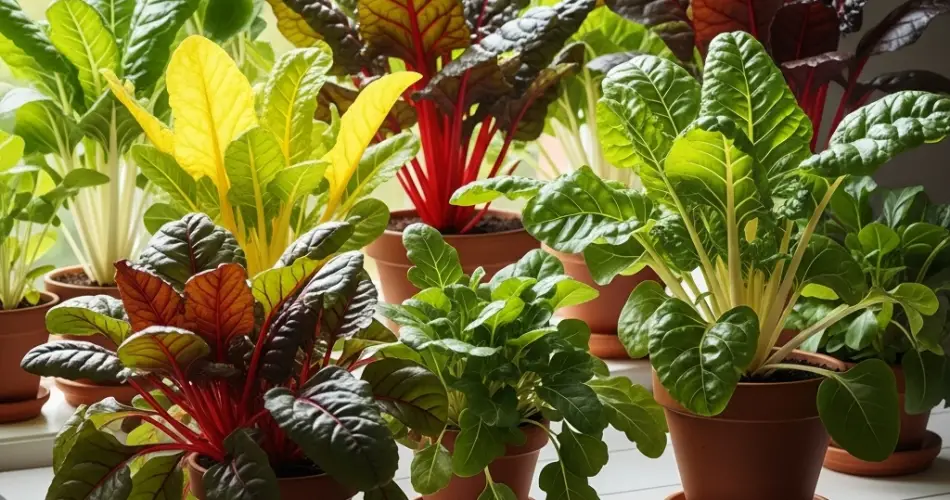Swiss chard is a beautiful and nutritious leafy green that makes a bold statement in any home garden. With its vibrant stems in shades of red, yellow, pink, and white, it’s not only a practical addition to your kitchen but also a visually appealing one. Fortunately, you don’t need a backyard or large plot of land to enjoy this colorful crop. Swiss chard grows exceptionally well in pots, making it ideal for balconies, patios, and sunny windowsills.
This guide will walk you through the step-by-step process of growing Swiss chard in containers, from choosing the right variety and container to harvesting your first flavorful leaves.
Why Grow Swiss Chard in Pots?
Swiss chard is a hardy, easy-to-grow plant that’s well-suited to container gardening. Here’s why it’s perfect for small spaces:
-
Colorful and attractive: Adds beauty to patios and balconies with rainbow-colored stalks.
-
Nutritious: High in vitamins A, C, and K, as well as iron and fiber.
-
Compact growth: Grows upright and doesn’t spread aggressively.
-
Tolerant: Handles both cool and warm weather better than many leafy greens.
-
Continuous harvest: Pick outer leaves and the plant keeps producing.
Whether you’re a beginner or a seasoned gardener, Swiss chard is a rewarding crop that thrives in pots.
Choosing the Best Variety
While all Swiss chard varieties grow well in containers, some are especially known for their color or productivity.
Popular varieties include:
-
Bright Lights – A vibrant mix of red, yellow, orange, and white stems; ornamental and tasty.
-
Fordhook Giant – Large, thick leaves with white stems; heat-tolerant and ideal for cooking.
-
Ruby Red (Rhubarb Chard) – Deep red stems and dark green leaves; striking appearance.
For the most colorful and visually pleasing container display, try planting a variety like ‘Bright Lights’ or mix several types together.
Selecting the Right Container
Swiss chard has a fairly deep root system, so choosing the proper pot is essential to encourage healthy growth.
Container recommendations:
-
Depth: At least 10–12 inches
-
Width: One plant per 10-inch pot, or multiple plants in a larger rectangular container
-
Material: Plastic, clay, ceramic, or fabric grow bags all work well
-
Drainage: Must have holes at the bottom to prevent root rot
You can even repurpose an old bucket or storage tub—just make sure it has good drainage.
Preparing the Soil
Swiss chard prefers rich, well-draining soil with a good balance of nutrients. The key is to keep the soil moist without becoming soggy.
Soil mix suggestion:
-
2 parts high-quality potting mix
-
1 part compost or aged manure
-
Optional: Add perlite or coconut coir for improved drainage and aeration
Moisten the soil before planting so it’s evenly damp but not saturated.
Planting Swiss Chard in Pots
Swiss chard is easy to grow from seed, but you can also use seedlings if you want a head start.
Planting from seeds:
-
Sow seeds ½ inch deep and about 3–4 inches apart.
-
Water gently and keep the soil moist until seeds germinate (usually 7–10 days).
-
Thin seedlings to 6–8 inches apart once they’ve developed their first true leaves.
Using transplants:
-
Space them 6–8 inches apart in your container.
-
Plant at the same depth as they were in the starter tray or nursery pot.
-
Water well after planting to help them settle in.
Sunlight and Temperature Needs
Swiss chard enjoys full sun but can also tolerate partial shade, making it flexible for various locations.
-
Light: 6–8 hours of sunlight per day is ideal.
-
Temperature: Grows best in 50°F to 85°F (10°C to 29°C).
-
Season: Can be planted in spring, early summer, or fall; it’s heat-tolerant and frost-hardy.
If you live in a hot climate, consider giving your plants some afternoon shade to prevent wilting.
Watering and Feeding
Consistent watering and occasional feeding will keep your Swiss chard lush and productive.
Watering tips:
-
Water when the top inch of soil feels dry.
-
Avoid overwatering—too much moisture can lead to root problems.
-
Use mulch or straw on top of the soil to retain moisture and reduce temperature swings.
Fertilizing:
-
Mix in compost or organic fertilizer when planting.
-
Apply a balanced liquid fertilizer every 2–3 weeks during active growth.
Harvesting Swiss Chard
Swiss chard can be harvested continuously, starting when the leaves are about 6–8 inches long.
How to harvest:
-
Pick the outer leaves first, leaving the inner ones to keep growing.
-
Use scissors or gently pull leaves from the base.
-
Harvest regularly to encourage new growth.
As long as the plant doesn’t bolt, you can enjoy fresh greens from the same plant for several months.
Troubleshooting Common Issues
-
Yellowing leaves: Usually due to overwatering or poor soil drainage.
-
Bolting (flowering): Happens in very hot or dry conditions—harvest quickly once this starts.
-
Pests: Watch for leaf miners and aphids; remove by hand or treat with insecticidal soap or neem oil.
Keeping your plants healthy with regular checks and good watering practices will help prevent most problems.
Final Thoughts
Swiss chard is a fantastic addition to any small-space garden. Its bright colors, nutritional value, and ease of growth make it a standout plant for container gardening. Whether you’re lining your balcony with rainbow-colored stalks or growing a few pots on a kitchen windowsill, Swiss chard brings beauty and flavor to your space.
With just a pot, some soil, and a sunny spot, you’ll be on your way to growing a vibrant and healthy crop of homegrown greens.



